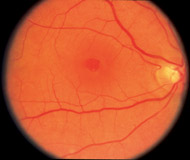Macular Hole
A macular hole is exactly what it sounds like: a hole in the macula, the center of the retina responsible for central and reading vision. Specifically, the hole or defect occurs in the fovea, the center of the macula and the most delicate part of the entire retina.
Macular holes almost always develop during the natural aging process, when the vitreous (the gel that fills most of the eye) thins and separates from the macula. This can pull on the macula and cause a hole to form. Less commonly, macular holes are caused by eye injury, intraocular inflammation, retinal detachment and other diseases. Most cases occur in people over the age of 50.
At first, a macular hole may only cause a small blurry or distorted area in the center of vision. As the hole grows over several weeks or months, central vision progressively worsens. Peripheral vision is not affected, and there is no risk of blindness.
 Surgery is over 95% effective for the treatment of macular holes. The procedure is outpatient with local anesthesia. A vitrectomy is performed to remove the vitreous gel, and then a gas bubble is injected into the eye to help the hole close. As the eye heals, the fluid is naturally replaced. Some early macular holes can be treated with ocriplasmin (Jetrea®) which is a drug injected into the vitreous of the eye, allowing some patients to avoid surgery.
Surgery is over 95% effective for the treatment of macular holes. The procedure is outpatient with local anesthesia. A vitrectomy is performed to remove the vitreous gel, and then a gas bubble is injected into the eye to help the hole close. As the eye heals, the fluid is naturally replaced. Some early macular holes can be treated with ocriplasmin (Jetrea®) which is a drug injected into the vitreous of the eye, allowing some patients to avoid surgery.
